| Ðóññêèé / English |
|

|
NUCLEAR SAFETY INSTITUTE OF THE
RUSSIAN ACADEMY OF SCIENCES
|
PREPRINTS
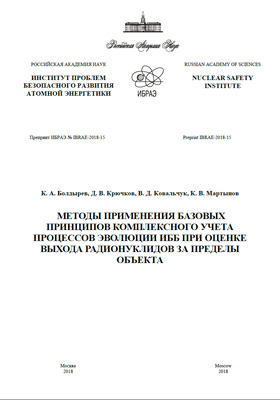 | Application methods of the principles of integrated accounting of the evolution of engineering safety barriers in the assessment of the release radionuclides from the object (preprint IBRAE-2018-15) Preprint IBRAE-2018-15 Boldyrev K.A., et al. The principles and the concept of creating a complex that combines calculation and forecasting tools for analyzing migration of radionuclides outside the facility, taking into account the evolution of security barriers is presented. The description of the processes evolution of engineering safety barriers and the structure of the computational and forecasting complex, taking into account the interacting physical and chemical processes are given. Bibliographical reference K.A. Boldyrev, D.V. Kryuchkov, V.D. Kovalchuk, K.V. Martinov. Application methods of the principles of integrated accounting of the evolution of engineering safety barriers in the assessment of the release radionuclides from the object / Preprint IBRAE-2018-15. — Moscow: NSI RAS, 2018. — 27 p. — Bibliogr.: 22 items. © Nuclear Safety Institute, 2018 |
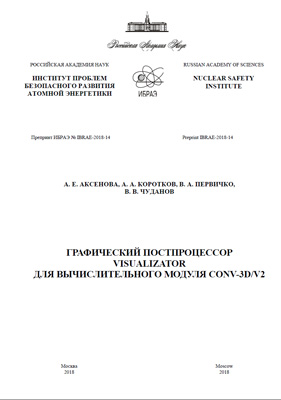 | Visualizator for CFD computing module CONV-3D. Graphic post-processing software (preprint ¹ IBRAE-2018-14) Preprint IBRAE-2018-14 Aksenova A.E., et al. The paper presents the Visualizator software that allows you to perform checking of the results of the calculations of CFD module CONV-3D. The document presents a graphical user interface (GUI) and computing features of the program computing experiments results, including visualization of the package that includes. Visualizator is a component of CFD module CONV-3D/V2 built for purposes of analysis of NPP safety. Bibliographical reference A.E. Aksenova, A.A. Korotkov, V.A. Pervichko, V.V. Chudanov. Visualizator for CFD computing module CONV-3D. Graphic post-processing software / Preprint ¹ IBRAE-2018-14. Moscow: Nuclear Safety Institute, 2018. – 46 p. – Bibliography: 9 references. – 100 copies. © Nuclear Safety Institute, 2018 |
 | Transitions between Volume-Localized Electron Quantum Levels of Fullerene C60 Ion (Preprint IBRAE-2018-13) Preprint IBRAE-2018-13 Rafael V. Arutyunyan and Alexander D. Vasiliev The excited short-lived volume-localized electron quantum levels (VLELs) existent due to Coulomb potential well inside positive ion C60+z are analytically investigated in the paper using a simplified spherical fullerene model. Hence, those electron levels appear exclusively after the ionization of neutral fullerene taking into account the unique geometrical shape of sphere. The existence of those levels is argued, and their basic parameters (the energy levels, the wave eigenfunctions) are approximately calculated. The analysis of electron beam interaction with the medium consistent of fullerenes ions C60+zis conducted as the application of the methods developed. The analytical dependencies of free electron recombination cross-sections for the capture to the volume-localized electron levels are obtained. It is shown that the probabilities of electron capture to these VLELs are considerably larger compared to capture to SLELs. Also, the calculational results of dipole moments for quantum transitions from fullerene ions VLELs to other VLELs and to SLELs with spontaneous photon emission are also presented in the paper. Finally, the principal possibility of coherent radiation generation on fullerene ions’ VLELs is discussed. Bibliographical reference Arutyunyan R.V., Vasiliev A.D. Transitions between Volume-Localized Electron Quantum Levels of Fullerene C60 Ion / Preprint IBRAE-2018-13 — Moscow: Nuclear Safety Institute, 2018 — 26 p. © Nuclear Safety Institute, 2018 |
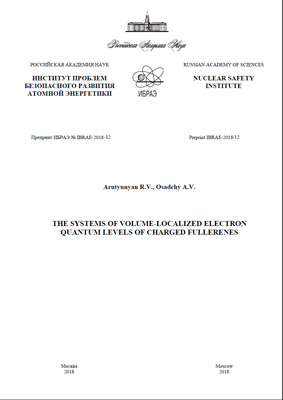 | The systems of volume-localized electron quantum levels of charged fullerenes (preprint ¹ IBRAE 2018-12) Preprint IBRAE-2018-12 Arutyunyan R.V., Osadchy A.V. The existence of a system of short-live discrete volume-localized electron quantum levels in positively charged fullerenes is theoretically and numerically demonstrated using the example of fullerenes C60 and C20. Unlike well-studied experimentally and theoretically electron states localized in a thin surface layer, these electron states are due to the flat part of the Coulomb potential of a positively charged fullerene sphere. The energy width of the system of such discrete volume-localized levels depends on the charge and increases with charge increasing. For C60+1, the energy width is 0.32 a.u. and increases up to 1.9 a.u. for fullerene C60+10. Thus, the electrons captured on these discrete levels of fullerene form a sort of a short-lived "nano-atom" or “nano-ion”, in which the electrons are localized inside a positively charged spherical “nucleus”. Numerous published papers have demonstrated theoretically and experimentally the existence of metastable positively charged C60 fullerenes with a charge of +10 or more, which suggests the possibility of experimental observation of the considering system of volume-localized electronic states. Bibliographical reference R.V. Arutyunyan, A.V. Osadchy. The systems of volume-localized electron quantum levels of charged fullerenes / Preprint ¹ IBRAE 2018-12. Moscow: Nuclear Safety Institute, 2018. — 13 p. — Bibliogr. 20 refs. |
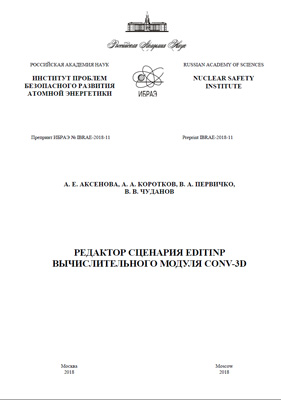 | Script editor EDITINP for CFD computing module CONV-3D (preprint ¹ IBRAE-2018-11) Preprint IBRAE-2018-11 Aksenova A.E., et al. The paper presents the software EDITINP that allows you to quickly create a script for computing the design module. The document presents a graphical user interface (GUI) editor and features of the boundary conditions, materials, and numerical schemes for computing experiments. The script editor is a one component of the system of preparing input data for CFD module CONV-3D for the analysis of the safety and NPP. Bibliographical reference A.E. Aksenova, A.A. Korotkov, V.A. Pervichko, I.V. Romero Reyes, V.V. Chudanov. Script editor EDITINP for CFD computing module CONV-3D / Preprint ¹ IBRAE-2018-11. Moscow: Nuclear Safety Institute, 2018. – 54 p. – Bibliography: 8 references. © Nuclear Safety Institute, 2018 |
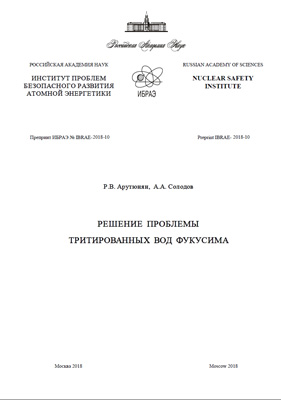 | The solution of the Fukushima tritiated waters problem (preprint ¹ IBRAE–2018-10) Preprint IBRAE-2018-10 Arutunyan R.V., Solodov A.A. The purpose of the paper is description and analisys of simplified technology of the disposal of ~106 tons of disaster waters now stored at Fukushima site. The starting “head” operation is distillation of the waters discussed. This operation separates and sends tritium and the rest of radionuclides to the two distinct products: first — 106 tons of the “target” distillate, contaning tritium and only tritium, and second – relatively compact “waste”, that is consentrated chloride brines, accumulating the total of nonvolatile radionuclides. As the first choice of final operation, the tritiated distillate may be pumped at land into the apropriate underground structures (so-called collectors) to conserve tritium here for some 100—200 years. The second choice is to pump tritiated distilate to the deep ocean waters at the place remote of ocean currents and of tropical cyclons pools. The relatively compacte waste (cloride brines) is to be provisionally stored at Fukushima site. The brines may be treated at the place and preparated for long-time storage or removed to the radiochemical plants for the final utilization. Bibliographical reference R.V. Arutunyan, A.A. Solodov. The solution of the Fukushima tritiated waters problem / Preprint ¹ IBRAE–2018-10. Moscow: Nuclear Safety Institute of the Russian Academy of Sciences (IBRAE RAN), 2018. – 17 p. – Refs.: 18 items. © Nuclear Safety Institute, 2018 |
 | The cost of the molybdenum isotopes (preprint ¹ IBRAE-2018-09) Preprint IBRAE-2018-09 Solodov A.A. The paper is logically related to the concept of accident–tolerant nuclear fuels and is dedicated to the production of neutron–transparent molybdenum of the isotope composition 98,100Mo. In the frame of gas–diffusion methode the estimate is developed of the 98,100Mo isotope mixtures cost. The new and unexpected result of the analisis is the cost equivalence of centrifugal and gas–diffusion 98,100Mo. The applications are specified which would stimulate industrial–scale production of isotopes 98,100Mo: accident–tolerant molybdenum claddings, advanced composite fuel elements of high radial thermal conductivity. The economics of novel material applications in composite fuel elements is found to be potentially positive. The molybdenum feature of basic importance is the possibility to recycle the post–reactor molybdenum after one–year storage. The conclusion is that molybdenum of isotope composition 98,100Mo is technologically availible and potentially affordable material of the reactor core. Bibliographical reference A.A. Solodov. The cost of the molybdenum isotopes / Preprint ¹ IBRAE-2018-09. Moscow: Nuclear Safety Institute of the Russian Academy of Sciences (IBRAE RAN), 2018. – 14 p. – Refs.: 26 items. © Nuclear Safety Institute, 2018 |
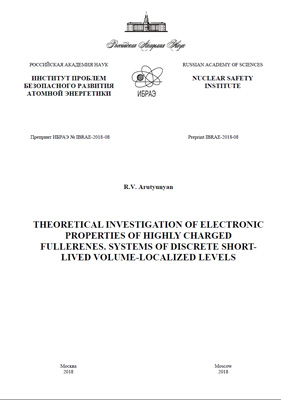 | Theoretical investigation of electronic properties of highly charged fullerenes. Systems of discrete short-lived volume-localized levels (Preprint IBRAE 2018-08) Preprint IBRAE-2018-08 Arutyunyan R.V. We study the electronic properties of charged fullerenes and onion-like structures in the framework of a simple physical model and show the existence of a system of discrete short-lifetime quantum levels for electrons in the model well potential. In the case of positively charged fullerenes, we find that the energy of the volumelocalized levels ranges from 1 eV to 100 eV. Electrons captured by these discrete levels localized in the volume generate a specific nano-atom wherein electrons or μ-mesons are localized inside a charged hollow sphere of fullerene playing the role of a nucleus in an atom. In case of negatively charged single-layered or onion-like structure fullerenes, Coulomb field creates a spherical potential well for positively charged particles (protons, nuclei of deuterium, tritium). In such a case, a system of discrete levels for positively charged particles is created wherein protons act as electrons and negatively charged sphere of fullerene plays the role of a nucleus. Bibliographical reference R.V. Arutyunyan. Theoretical investigation of electronic properties of highly charged fullerenes. Systems of discrete short-lived volume-localized levels / Preprint IBRAE 2018-08. — Moscow, 2018 — 12 p. — Bibliogr. 44 items. © Nuclear Safety Institute, 2018 |
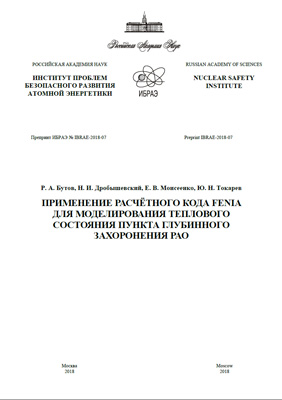 | Application of FENIA code for modelling of deep geological radioactive waste repository thermal state (preprint IBRAE-2018-07) Preprint IBRAE-2018-07 Butov R. A., et al. One of the aspects of long-term safety demonstration for deep geological radioactive waste repository project in Russian Federation — thermal state modeling — is studied in the paper. The computer code FENIA developed by the authors and the numerical simulation results for 3D temperature field inside the repository and in the host rock are presented. 3D non-stationary non-homogeneous heat transfer equation is solved in the code by use of finite-element approach. Further within the scope of this approach coupling with mechanical and hydraulic models will be implemented resulting in fully coupled thermal-hydro-mechanical (THM) code. Bibliographical reference R.A. Butov, N.I. Drobyshevsky, E.V. Moiseenko, Yu.N. Tokarev. Application of FENIA code for modelling of deep geological radioactive waste repository thermal state / Preprint IBRAE-2018-07 — Moscow: Nuclear Safety Institute, 2018 — 27 p. — Bibliogr: 20 items. © Nuclear Safety Institute, 2018 |
 | Prognostic complex CORIDA (Preprint IBRAE-2018-06) Preprint IBRAE-2018-06 Blokhin P.A., et al. The paper presents the description of the developed calculation and prognostic complex CORIDA, intended to solve the tasks appearing when basing the radiation safety of objects using nuclear power in all stages of their life cycle. The explanations of solutions accepted for complex architecture, main modules functions, and selection of basic program means are presented. Considering the specificity of the tasks solved, the complex provides modules for calculation of radionuclide compositions of irradiated materials and their radiation characteristics, to model the ionizing radiation fields my Monte Carlo method, and specialized graphical editor and converter to simplify the laborious input data preparation procedure in the modeling programs formats. Bibliographical reference P.A. Blokhin, A.I. Blokhin Yu.E. Vaneev, I.V. Sipachev, P.A. Kizub. Prognostic complex CORIDA / Preprint IBRAE-2018-06. — Moscow: NSI RAS, 2018. — 16 p. — Bibliogr.: 27 items. © Nuclear Safety Institute, 2018 |
 |
IBRAE RAN © 2013-2024 | Site map | Feedback |